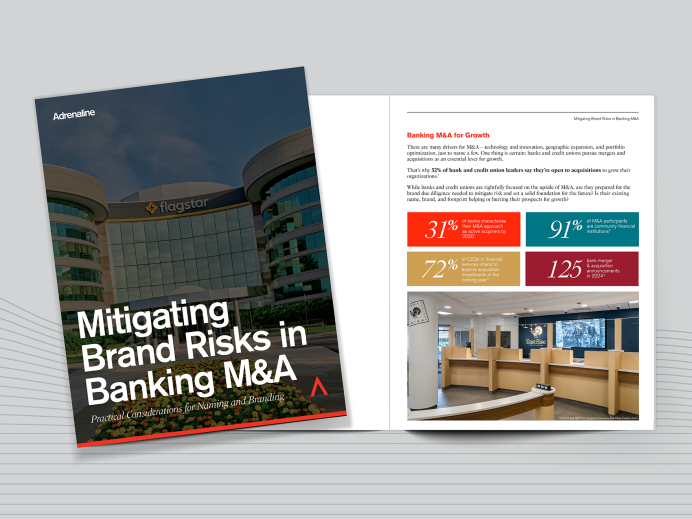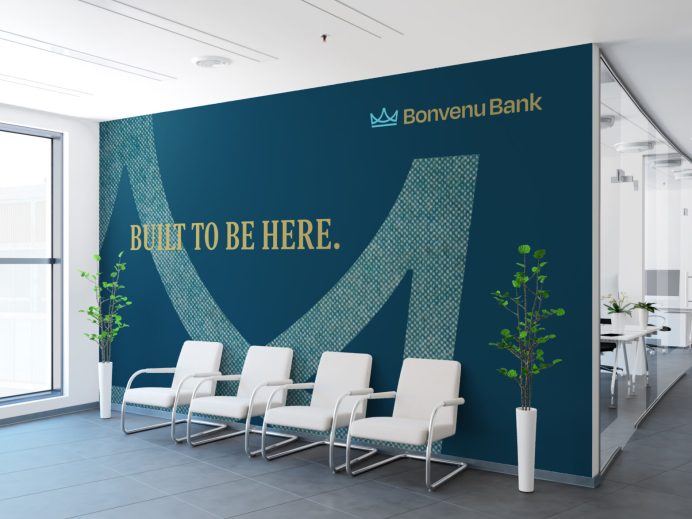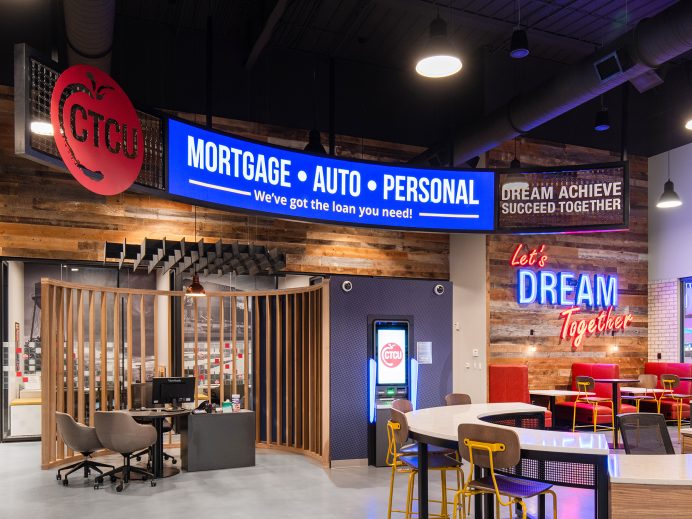Why Smart Companies Should Prioritize Employer Brand Strategy
How a holistic employer brand strategy makes for better companies
A conversation with Adrenaline’s Chief Brand Officer Juliet D’Ambrosio about brand’s role in creating culture and building advocacy from the inside-out
In our last article on strategy fundamentals for financial institutions, we discussed how strong strategy provides a solid foundation for building business success. Strategic brands make the most meaningful connections with audiences that matter. And while many organizations may prioritize external audiences as their primary target for outreach and engagement, internal audience influence is just as important. In fact, it’s employees who provide the fuel to turbocharge business success through their brand loyalty and advocacy.
To talk about employer brand strategy, company culture, and employee engagement, we sat down with our expert on all things brand – Adrenaline’s Chief Brand Officer Juliet D’Ambrosio – for a discussion that’s as entertaining as it is enlightening.
People may have a basic understanding of branding, but they may not know what employer brand strategy is and why it matters. Can you give us a grounding?
Yes! Employee engagement and company culture are an outgrowth of a holistic employer brand strategy. In our process advising clients as well as within our own company, that starts with the employer value proposition or EVP, which is borne of the overall brand strategy and supported by our values and an articulation of the company mission. The EVP sets the stage for how we are going to embody and live our values through behaviors. And it becomes a fulcrum around which we make decisions about hiring, recruiting, performance management and reviews, and employee experience programs. Ultimately, the employer value proposition helps determine where we want to invest and what we want to grow as an organization.
What happens when companies do not prioritize employer brand strategy?
That’s a great question. From research, we know that an emphasis on employer value proposition and an organization’s brand as it’s reflected by employees translates directly into business performance and profitability. Intuitively, we all understand that happy, engaged employees are more productive. On the flip side is employee attrition. When people don’t know what an employer brand stands for, they’ll leave a company because they’re not supported, they don’t understand the mission, and they feel like their growth is not prioritized.
There are hidden costs to attrition every time an employee leaves. It’s so much more expensive for the company to recruit, hire and train a new employee than to keep a current employee engaged. Getting the right people for the right roles is increasingly competitive. But with an emphasis on culture, companies are able to control some of those costs. I do think it’s important to mention here that there has been a shifting landscape in workplaces since before the pandemic, but COVID really catalyzed it.
New generations want fair compensation, yes. But they want companies to show they value people’s mental health and well-being, prioritize a work-life balance, and see them as people first, not just workers. Even more, people want to work with companies that stand for something. They want companies to understand corporate impact on communities and the environment. People want to connect with a company that values what they value and helps to be a force for good in the world. An employer value proposition that evokes these essential values helps a company have a real competitive edge in attracting and retaining modern talent.
Lastly, while this may sound very tactical, it really has a huge impact. Companies that have invested in their internal brand values have a distinct advantage in the hiring process. The time it takes for a company to recruit and how quickly they extend their first offer to their top candidate to when that candidate accepts is significantly shortened when potential hires see a company with a strong employer brand. Companies that have to move to their second and third-choice candidates are unable to invest in their top talent and onboard as quickly, which has a huge opportunity cost. The bottom line is that brands should consider their internal audiences just as carefully as they do their external audiences.
Talk about financial brands specifically. What do you see in the financial services landscape as it relates to employer brands?
You know the financial industry is not unlike other industries. It’s not really a laggard as much as it has just been focused on other priorities – consolidation across the market, keeping up with technology, the move towards digital transformation, etc. So, it’s not that they’ve ignored culture, employee experience or the employer brand proposition at all. It just hasn’t been an area of focus for their organization, and we do see the impact of that, especially in attracting and retaining talent.
The other really big factor for financial institutions is that the positions they’re hiring for are in many ways different now with staff doing fewer transactions and more consultation. They need less frontline staff to come in to perform very specific tasks for customers in the teller line. Financial services companies are now looking for people with a different type of training and skillset – people who are able to lead those deeper, more high-level conversations and become true advisors to their customers.
That doesn’t mean everyone working in financial services is a wealth or investment advisor, but it does mean that they’re able to look across all the products and services the bank has to offer and map those to where someone is in their financial journey, coupled with expert advice. So, because of a shift toward digital transactions, banks and credit unions are catching up to the demands of that different workforce.
Institutions are getting much more digitally savvy. They’re hiring people with engineering, computer science, and data science backgrounds. Banks and credit unions are getting smarter about how they both meet the needs of current customers and prospect for new ones, so they require a new level of in-house talent and expertise. I think the employer brand landscape is a mixed bag – needing to focus on talent acquisition due to the changing landscape, which in turn creates this need for developing better employee experiences.
Given these kinds of demands for acquiring and retaining talented people, how are institutions building employer culture that’s sticky?
For community institutions, their entire reason for existence is that they create these highly personal relationships with their customer or member base. As we look out across the landscape, what we’re seeing is that community banks and credit unions are making real investments in employee experience. We’re watching institutions just realize enormous growth and lead the industry forward, due in no small part to their focus on building a strong employer brand strategy.
One great example that comes to mind is Origin Bank. Their CEO and Chairman go once a month to personally meet and have lunch with all new employees across the company. They have programs like Culture Day and Experience Day to build bonds with employees and support their staff. Showing up that way has real results for them. Origin has grown into one of the regional powerhouse financial institutions in their communities. So, this focus on employer brand is not only the right thing to do for their people, it’s also really good for business.
In building an employer brand strategy, it usually starts at the brand launch, right? But how do companies carry that through?
There’s the brand strategy which really positions the organization in a competitively unique way. We launch the employer value proposition at brand launch because that is the place where we begin to talk about how we are going to tell the story of who we are not only to customers or members and the market, but really what this means for us internally.
There is usually training around values and culture that happen either at the brand launch or very quickly thereafter. For example, one credit union brand that launched at the end of last week started their employee experience culture training early the following week. We want it to be very closely connected because we want the energy of that brand launch to translate into employee experience, and we want people to see the link between the two of them.
The employee experience typically continues to build over the next 18 months, as a best practice. That doesn’t mean that your employee experience, training or efforts stop after 18 months. But a real focus especially if there is a change in brand strategy is concentrated over the next 18 months. Brands will do continual training modules – once a month, or once a quarter, for example – on the values and the culture with the overall brand.
A very tactical example of how this plays out is the way we work with human resources. With our clients, we know that typically employer culture and brand strategy comes out of C-Suite, and HR is heavily involved, because they’re the ones that activate the brand internally. So, we will often work with HR in development of the employee value proposition and also how the values of the brand not only connect to but inform performance management.
This translates into how they’re measuring employees year-over-year and how they conduct their annual reviews, for example. HR sees how the company and its people embody the brand’s values. Ultimately, the employer brand is developed concurrently with the brand strategy. We’ll introduce employer brand strategy at brand launch and then continue to build throughout the year, going deeper into the organization through their HR department and also through their training programs.
Adrenaline just recently went through a brand refresh themselves. Can you tell us about the employer brand strategy around this refreshed brand positioning?
Yes, I’d love to! It’s fun to talk about, because we’re sort of the living embodiment of the best practice we recommend for our clients. So, we launched Adrenaline’s refreshed brand and new positioning to capture not only the company we’ve evolved into, but also to be aspirational to our team and our place in the industry. We wanted the brand to say everything that we offer to the market, but our tagline “lead change” also becomes a rallying cry for our internal employees, as well.
After the internal brand launch, we followed up with an entirely employee-driven experience and culture building workshop. In it, we workshopped our company values together and how we could translate values into behavior. We believe in company values that are coauthored not only by our leadership, but by all of our people to reflect the values we believe in and the company we want to work for. All of that input that we got from that session, we then reflected all of that back to the company in a follow-up Town Hall, with a co-authored set of four company values that are going to be the foundation for Adrenaline’s culture moving forward.
Future-facing, we used the brand launch as a foundation to build on. Then over the course of this year, culture building is a corporate initiative that I’m leading. And once a quarter we are going to continue to build out our strategy through training around our values, training around performance management and then training in the development of milestones, like annual company celebrations and wins that allow us connect, inspire and build both professional and personal relationships across the organization. It’s exciting to see this kind of co-creation of our brand come to life.
For more information on creating culture programs that build internal advocacy or to speak with one of our brand strategy experts, contact us at info@adrenalinex.com. Stay tuned to Adrenaline’s Insights channel for branding best practices. Be sure to also stay tuned in to Believe in Banking as it highlights industry news and views for banking leaders.
Adrenaline is an end-to-end brand experience company serving the financial industry. We move brands and businesses ahead by delivering on every aspect of their experience across digital and physical channels, from strategy through implementation. Our multi-disciplinary team works with leadership to advise on purpose, position, culture, and retail growth strategies. We create brands people love and engage audiences from employees to customers with story-led design and insights-driven marketing; and we design and build transformative brand experiences across branch networks, leading the construction and implementation of physical spaces that drive business advantage and make the brand experience real.




